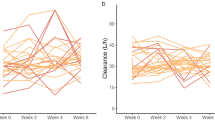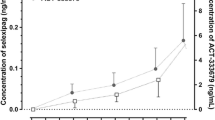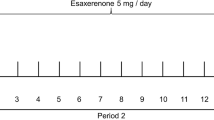Abstract
Objective: To determine midazolam pharmacokinetics in healthy Mexican volunteers and to compare them with the pharmacokinetics reported for other populations.
Patients and Methods: Eleven healthy Mexican (mestizo) males received a single midazolam dose intravenously (7.5mg) and orally (15mg) with a washout period of at least 7 days. Midazolam plasma concentration was determined by high performance liquid chromatography. Pharmacokinetic parameters were obtained and compared with historical controls reported for other populations.
Results: Midazolam pharmacokinetic parameters in Mexicans determined after intravenous administration were (mean ± SEM): clearance 2.54 ± 0.43 ml/min/kg, volume of distribution 0.52 ±0.1 L/kg and half-life 2.61 ± 0.42 hours. After oral administration the area under the plasma concentration-time curve (AUC) was 941 μg/L· h and the maximum concentration was 271 μg/L. There was a significant correlation between AUC values observed after oral midazolam and clearance (r = −0.71, p < 0.02). Systemic midazolam clearance observed in Mexicans was lower, while oral bioavailability was higher, compared with the values reported in the literature for healthy Caucasian volunteers under similar conditions.
Conclusion: Midazolam bioavailability in Mexicans is higher than that reported for Caucasians. This appears to be because of a reduced systemic clearance. Since midazolam is mainly eliminated via biotransformation by CYP3A4, our data suggest the existence of interethnic variations in the activity of this enzymatic system. Increased midazolam bioavailability may lead to an increased incidence of adverse effects. Therefore, administration of midazolam should not be blindly extrapolated from one population to another. Midazolam doses in Mexicans should be reduced in relation to those used in Caucasians.
Similar content being viewed by others
References
Kalow W. Interethnic variation of drug metabolism. Trends Pharmacol sci 1991; 12: 102–7
Daly AK, Cholerton S, Gregory W, et al. Metabolic polymorphisms. Pharmacol Ther 1993; 57: 129–60
Vesell ES. Genetic and environmental factors affecting drug disposition in man. Clin Pharmacol Ther 1977; 22: 659–79
Darmansjah I, Muchtar A. Dose response variation among different populations. Clin Pharmacol Ther 1992; 52: 449–52
Rashid TJ, Martin U, Clarke H, et al. Factors affecting the absolute bioavailability of nifedipine. Br J Clin Pharmacol 1995; 40: 51–8
Hoyo-Vadillo C, Castañeda-Hernández G, Herrera JE, et al. Pharmacokinetics of nifedipine slow release tablet in Mexican subjects: further evidence for an oxidation polymorphism. J Clin Pharmacol 1989; 29: 816–20
Sowunmi A, Rashid TJ, Akinyika OO, et al. Ethnic differences in nifedipine kinetics: comparisons between Nigerians, Caucasians and South Asians. Br J Clin Pharmacol 1995; 40: 489–93
Castañeda-Hernández G, Palma-Aguirre JA, Montoya-Cabrera MA, et al. Interethnic variability in nifedipine disposition: reduced systemic plasma clearance in Mexican subjects. Br J Clin Pharmacol 1996; 41: 433–4
Palma-Aguirre JA, González-Llaven J, Flores-Murrieta FJ, et al. Bioavailability of oral cyclosporine in healthy Mexican volunteers: evidence for interethnic variability. J Clin Pharmacol 1997; 37: 630–4
Thummel KE, O’Shea D, Paine MF, et al. Oral first-pass elimination of midazolam involves both gastrointestinal and hepatic CYP3A-mediated metabolism. Clin Pharmacol Ther 1996; 59: 491–502
Chan K, Jones RD. Simultaneous determination of flumazenil, midazolam and metabolites in human biological fluids by liquid chromatography. J Chromatogr 1993; 619: 154–60
Foster TS, Hamann SR, Richards VR, et al. Nifedipine kinetics and bioavailability after single intravenous and oral doses in normal subjects. J Clin Pharmacol 1983; 23: 161–70
Clausen TG, Wolff J, Hansen PB, et al. Pharmacokinetics of midazolam and a-hydroxy-midazolam following rectal and intravenous administration. Br J Clin Pharmacol 1988; 25: 457–63
Pentikäinen PJ, Välisalmi L, Himberg J-J, et al. Pharmacokinetics of midazolam following intravenous and oral administration in patients with chronic liver disease and in healthy subjects. J Clin Pharmacol 1989; 29: 272–7
Smith MT, Eadie MJ, Brophy TO. The pharmacokinetics of midazolam in man. Eur J Clin Pharmacol 1981; 19: 271–8
Allonen H, Ziegler G, Klotz U. Midazolam kinetics. Clin Pharmacol Ther 1981; 30: 653–61
Borneman L, Crews T, Chen S, et al. Influence of food on midazolam absorption. J Clin Pharmacol 1986; 26: 55–9
Koopmans R, Dingemanse J, Danhof M, et al. The influence of dosage time of midazolam on its pharmacokinetics and effects in humans. Clin Pharmacol Ther 1991; 50: 16–24
Olkkola KT, Aranko K, Luurila H, et al. A potentially hazardous interaction between erythromycin and midazolam. Clin Pharmacol Ther 1993; 53: 298–305
Kupferschmidt HT, Riem Ha H, Ziegler WH, et al. Interaction between grapefruit juice and midazolam in humans. Clin Pharmacol Ther 1995; 58: 20–8
von Moltke LL, Greenblatt DJ, Schmider J, et al. Metabolism of drugs by cytochrome P450 3A isoforms. Implications for drug interactions in psychopharmacology. Clin Pharmacokinet 1995; 29Suppl. 1: 33–44
Kleinbloesem CH, Van Brummelen P, Faber H, et al. Variability in nifedipine pharmacokinetics and dynamics: a new oxidation polymorphism in man. Biochem Pharmacol 1984; 37: 2507–10
Breimer DD, Schellens JHM, Soons PA. Nifedipine: variability in its kinetics and metabolism in man. Pharmacol Ther 1989; 44: 445–54
Castañeda-Hernández G, Hoyo-Vadillo C, Palma-Aguirre JA, et al. Pharmacokinetics of oral nifedipine in different populations. J Clin Pharmacol 1993; 33: 140–5
Ashan CH, Renwick AG, Macklin B, et al. Interethnic differences in the pharmacokinetics of oral nifedipine. Br J Clin Pharmacol 1991; 31: 399–403
Ashan CH, Renwick AG, Waller DG, et al. The influences of dose and ethnic origins in the pharmacokinetics of nifedipine. Clin Pharmacol Ther 1993; 54: 329–38
Rosestein Ster E. Diccionario de Especialidades Farmacéuticas, Editorial PLM S.A. de C.V., Mexico, D.F., 1998
Author information
Authors and Affiliations
Corresponding author
Rights and permissions
About this article
Cite this article
Chávez-Teyes, L., Castañeda-Hernández, G. & Flores-Murrieta, F.J. Pharmacokinetics of Midazolam in Mexicans Evidence for Interethnic Variability. Clin. Drug Investig. 17, 233–239 (1999). https://doi.org/10.2165/00044011-199917030-00008
Published:
Issue Date:
DOI: https://doi.org/10.2165/00044011-199917030-00008




